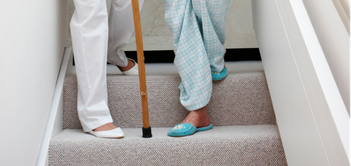The most common myth surrounding seniors and falls? Falls are a normal part of aging. Falls are not a foregone conclusion. Unfortunately, falls are the No. 1 cause of injuries among Canadians 65 and over. Between 20 and 30 percent of Canadian seniors experience one fall each year.
It does not have to be this way. With education and prevention, falls are less likely to affect seniors’ activities and independent living. Here are four more fall myths out of step with current research in fall prevention.
Myth: Falls are the result of wrong-place, wrong-time bad luck.
In reality, falls are the result of a complex web of risk factors. Everything from baseline health, socio-economic status, vision, diet and the weather can lead to a fall. The first step to fall prevention is a comprehensive risk assessment performed by a trained professional. Many of our ComForCare offices provide free in-home risk assessments. Call 800-886-4044 for more information.
 Myth: Most falls happen outside.
Myth: Most falls happen outside.
Wrong: almost half of all falls happen inside the home.
Danger zones include stairs and the bathroom because of uneven surfaces and slippery bathtubs and showers. Other risk factors at home include rugs, electrical cords, poor lighting and clutter on the floor.If someone moves to a retirement residence or downsizes to a smaller home, be on the lookout for falls. Fall risk increases when seniors move to a new space. ComForCare has created an infographic with some great tips to help reduce fall risks at home. For example, installing non-skid strips and a shower chair can help lower the likelihood of bathroom falls.
Myth: A cane or walker is a foolproof solution.
Yes and no. Mobility devices can be an important part of a multifaceted plan to prevent falls. However, an assistive device can become a fall hazard if it is not maintained or if it does not fit. To make sure a mobility device does not become a fall risk, always check for worn cane tips and loose wheels on walkers. Make sure all assistive devices are not too heavy or set to the wrong height.
Myth: You can’t fall if you stay sitting down.
Staying sedentary is not the answer. Stopping all physical activity leads to muscle weakness and decreased physical fitness, a major risk factor for falls. Exercise has a vital role in fall prevention. Exercise can be done at home but many Canadian gyms are starting to tailor activities to seniors. The best exercises for fall prevention include strength training, balance exercises and walking. Exercise needs to be a regular part of a senior’s daily routine for fall prevention and for overall physical and mental health. Sometimes, seniors stop being active because they fear falling, especially if they have fallen in the past. In reality, being afraid to fall is another fall risk factor.
Knowledge can help dispel myths and keep seniors on their feet. Make sure you get all the facts and information you can about how to lower fall risks. For more fall facts, check out the Public Health Agency of Canada Seniors' Falls in Canada: Second Report.
![Duel-Logo-CFC-AYS[rgb]](https://blog.comforcare.ca/hs-fs/hubfs/Duel-Logo-CFC-AYS%5Brgb%5D.jpg?width=525&name=Duel-Logo-CFC-AYS%5Brgb%5D.jpg)